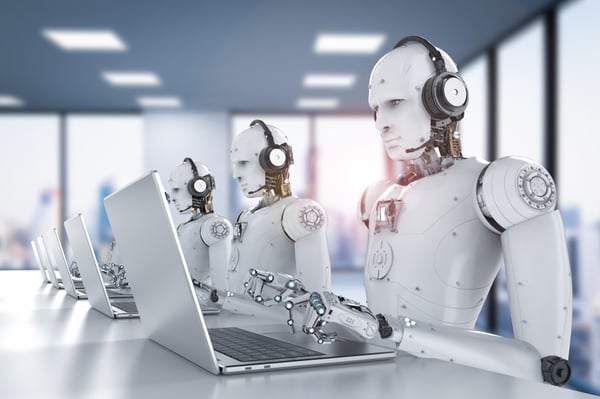How to Stop Yourself Being Replaced by a Robot
Written by Tessa Melkonian Friday 01 February 2019
There are many developments that are likely to have an effect on the way we work, the future of organisations and how business leaders manage their workforces. Gig employment, artificial intelligence and industry 4.0 are three recurring topics in the thoughts and conversations of business professionals and managers.
One development that is certain to affect working practices profoundly is the widespread use of robots. However, opinion is mixed on the use of robots in the workforce.
On the one hand, robots can drastically increase productivity, complete time-consuming, remedial tasks at a faster pace, and increase the consistency of specific practices. On the other hand, there is much scaremongering around the implementation of robots, particularly the impact this will have on lower-skilled workers. Many claim that the more robots introduced into the workforce the more such workers will suffer, as they are replaced and ultimately unemployed at the hands of machines.
We have already seen this in sectors such as manufacturing, through the use of robots on production lines; and retail, in the form of self-checkout machines. Though this has been broadly accepted, it does still spark concern that the increased use of robots in the workforce could dramatically and negatively affect people’s lives by causing mass unemployment, as the technologies capability evolves.
Thus far the ‘robotisation’ of the workforce has essentially affected lower-skilled workers – with the exception of some specific desk roles such as the disappearance of more than 600 traders at Goldman Sachs. Looking ahead, management is one of the – perhaps surprising – functions that could soon be taken over by machines (see McKinsey’s 2016 report).
Are we so sure that a robot could not take over the role of manager?
The answer depends on what type of manager we’re talking about. It is generally agreed that there are two main behavioural models for managers: management 2.0 and management 3.0.
The management 2.0 model is essentially where the manager acts as a mouthpiece for hierarchy, conveying main objectives, distributing tasks and projects, evaluating and collating data and reporting back to higher management. Managers who fit into this role, and act with little people management skills or emotional intelligence, are likely to be replaced by robots in the not-so-distant future. As AI evolves, we are likely to see the delegation tasks, giving of feedback on objectives and non-biased end-of-year assessments be completed by robots.
However, managers who fit the management 3.0 model are much more likely to stand in good stead compared to robots. Managers who fit this model use their skills to reinforce the talents of their team, give employees enough autonomy and meaning so that they feel free to innovate and also interact with workers on a human level. 3.0 managers have strong emotional intelligence and people management skills, connecting with their employees on an emotional level in order to get the best out of them. This management model is something that no robot should be able to achieve anytime soon.
So, what do managers need to do to stop themselves from being replaced by robots?
Managers must adopt the management 3.0 model, and develop their people management skills if they want to continue in their roles and contribute to their organisation’s future. Developing and improving these skills will help managers to excel in the areas that currently only a human is able to deliver. The likelihood is that in the future robots will take over those routine delegation and analysis tasks that fit the management 2.0 model, becoming a considerable asset to those who prioritise the human side of management. With robots completing the low value-added activities such as distributing tasks and evaluating work, managers will be enabled to maximise their focus on their relationships with their staff to promote innovation and dedicate more attention to strategic business thinking.
The arrival of robots within the workplace will have a profound impact on the management of organisations, industries and workforces. It will force managers and leaders to rethink their roles and behaviours. We’re exploring this at Emlyon Business School’s Institute for Artificial Intelligence in Management (AIM).
The teaching and development of management, not only at business schools, but on specific training courses and at an organisational level, must focus on ensuring managers have strong people management skills, emotional intelligence and the ability to get the best out of their teams. But they must also be taught how to use AI, to streamline their practices and gain in performance.
The arrival of robots in management is inevitable, and managers should have every interest in embracing this. To do so, they must adopt the managerial 3.0 model and strengthen their people management skills, in order to minimize the risk of being replaced by machines.
Image: Shutterstock
Filling in the Gaps Report
This research highlights the ongoing challenges in closing the gender pay gap.
“As managers, we can help improve the UK economy”
Simon Takel CMgr FCMI on how CMI resources help him navigate change in the further education sector
Giving Engineering Students a Competitive Edge
Discover how Newcastle College’s CMI Dual Accredited Engineering Management degree empowers future engineering leaders.
Pink suits and ice-breakers: what we learned at CMI Communities Live, Birmingham
Experts gathered in the West Midlands to share their ideas for future-proofing leadership
Blog
This is a space for people to stay up-to-date with all the latest knowledge, opinions and commentary on management and leadership topics from some industry leaders.
Members See More
CMI Members have access to thousands of online learning and CPD resources. Learn more about our membership benefits
Join The Community
CMI offers a variety of flexible membership solutions, tailored to your needs. Find out more and get involved in the CMI community today.
